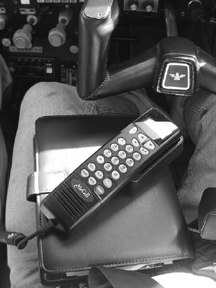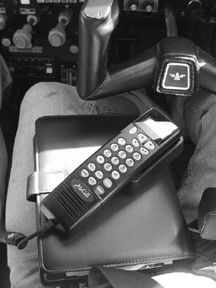
Now that the wireless world stands poised to equip every man, woman and child on the planet with a PDA-personal downtime annihilator- the era of the affordable airborne telephone has finally emerged.
After literally years of false starts and technical plot twists, AirCell, Inc. has gone from the are-you-guys-still-out-there phase to genuine hardware and service thats ready for purchase.
Although AirCells network is still only about half complete, the system provides good coverage at high altitudes east of the Mississippi and by years end, most of the service gaps will be filled. We recently flew the system with AirCells test pilot Keith Griffith in a Mooney, tried some chatty phone calls with the home office and even downloaded some weathermaps from the Web. It all worked flawlessly and frankly, for $1.75 a minute, it ought to.
Bottom Line First
Did we say affordable airborne cell service? Yes, but thats not to say cheap. Like everything else, cost is relative and relative to plain-vanilla ground cell service, where the provider begs you to take a free phone and gives you a bunch of minutes gratis, AirCell service is pricey indeed.
First the hardware: AirCell has two phone models, the economy AT.01 and the all-the-bells-and-whistles AGT.01. The former sells for $3995, the latter for $7995. Garmin will soon release its NavTalk Pilot cellphone, which will retail for $2990, a bargain in the avionics world but still breathtakingly expensive by cellphone standards.
AirCell offers five basic service plans (see the table at right), the cheapest being $19.95 per month, plus $1.99 per minute for airtime and $10 a month lines charges if you specify more than one line in the aircraft. Domestic long distance charges are included, but not international long distance.
Still no bargain by cellphone standards but nearly dirt cheap compared to other flight phone options used by the jet set crowd for years. And therein lies AirCells marketing strategy; airborne cell service for the businessman in a Bonanza, not the suit in a Gulfstream. (We suspect, however, than any bottom-line savvy suits will cast more than a casual fiduciary glance at this system, if they do mostly domestic travel.) So once youre past the installation cost-say $4000 for the Garmin-youre on the hook for $240 to $360 a year, plus the airtime. As we said, reasonable, but not cheap.
Ground Network
AirCells technological breakthrough is something called frequency re-use, which is done through proprietary software and antenna design. The show-stopping problem with conventional cellphones used from airplanes is that they hit many cell sites at once, bogging down and confusing the ground network. For that reason-or so weve been lead to believe-FCC regulations prohibit airborne cellphone use.
Although AirCell uses standard cellphone frequencies, it does so in a way thats transparent to the ground-based cell network. Indeed, AirCells specialized equipment shares sites with ground-based cell providers, an arrangement that took some effort on AirCells part. (Theyve been grinding away at this since 1991 and fielded a demonstration system in 1992, which was we’ll received by the bizjet crowd.)
As of late spring 2000, AirCell had 83 of 150 sites installed and operating with 95 percent network completion promised by the end of year. Ultimately, cell coverage is supposed to provide gap-free (mostly) service from about 5000 feet anywhere in the Continental U.S., except for terrain shadowing in mountainous areas. Its not quite there yet. AirCells current coverage map shows gap-free coverage only east of the Mississippi and then only from 20,000 feet, so we have to take AirCells future coverage claims somewhat on faith for now. When we flew with AirCells Keith Griffith in Altoona, Pennsylvania, he was soon to run tests on a new site in eastern Ohio.
Airborne Hardware
As befits a company test bed, AirCells Mooney had two systems aboard. Essentially, these are Motorola phone systems adapted for AirCells proprietary signal processing. The guts of the phone are installed in a box in the avionics bay and wired to a belly-mount antenna and a conventional handset.
The handset can be installed in a cradle in the cockpit wall or anywhere else thats convenient. (AirCell will soon introduce a flush-mounted model.) It can be used just like a standard telephone or-better-wired into the ships audio system through a phone position on the audio panel. AirCells test aircraft has a PSEngineering PMA 7000, an audio panel specifically configured for cellphone operation.
It can be set up to allow anyone in the aircraft to use the phone through a headset, without disturbing the rest of the aircraft occupants. This requires a dedicated switch at each intercom station so installation of this system can become somewhat involved, typically costing between $1500 and $2500.
We suspect most owners would be quite satisfied with pilot-only phone access. (In any case, the handset can be passed to anyone in the cabin; noisier, perhaps, but still workable.) Placing a call involves selecting the phone position on the audio panel and simply dialing the call, just as with a standard cellphone. You hear the dial sidetone and ring, just as with a conventional phone.
The acid test: How does it sound? We think its best compared to using an ordinary office or home telephone. We tried calls from the aircraft and to the aircraft and other than the slightest background noise, it wasnt obvious that the call was originating from other than a terrestrial phone. Using Bose Headset X noise-canceling headsets, we would rate the audio performance as vastly better than the lousy digital service from our ground cell provider (Bell Atlantic Mobile) and far superior to the typical flight phone service available from an airline seatback. (And cheaper, too.)
Signal processing is analog, not digital, and we noted no background noise or static. However, we were operating within 50 miles of the cell site. At greater distances, says AirCell, callers will notice some background noise, increasing until the call is dropped beyond sight of the cell. Obviously, the higher you fly, the less the problem. Incoming calls, of which we tried several, ring the phone with enough volume to easily hear with the headset on. However, the ringer tone can be piped through the audio panel as well.
Data, Too
Since everyone wants fax, e-mail and Web access from every location on the planet, AirCell service does that, too. We tried downloading some Web images on a Sony Vaio laptop provided by AirCells Griffith. Although AirCell is supposed to work with any standard modem, the Vaio was equipped with a specially modified AirCell modem called a Link Maker. The company says this modem is optimized to work at AirCells 9600-baud data limit and accounts for the nuances of in-flight cellular communications. Were not sure what that means but the modem will cost you $249.95.
The hassle factor of fussing with a computer inflight is not trivial, in our view. In a small cockpit such as the Mooneys, hooking up the modem and perhaps external power is a nuisance. With two people in the cockpit, there’s no room for even a small computer such as the Sony, although this is less of a problem if the computer can be placed on an unoccupied right seat. We logged onto WeatherTap and launched immediately into the worst-case load test: A busy color NEXRAD radar image of an ugly line of thunderstorms west of Chicago. Download time: Just shy of two minutes. Although this is hardly a fair comparison, our office cable modem service does the same in about two seconds and a standard dial-up connection with a 56K modem downloaded in 15 seconds. Text-only data-METARs, TAFs and winds, for example, download in a matter of seconds. Anyone accustomed to high-speed internet access will find AirCells data rate to be glacial. Then again, compared to the alternative-nothing-it may be a revelation.
The world of airborne datalink is, at this point, too chaotic to judge. Were at a loss to make any product or service recommendations so, against that backdrop, AirCell is a relatively affordable way to get into Web-based weather datalink in a hurry. To keep the airtime charges from escalating out of hand and until more convenient hardware emerges, we imagine most users will employ Web datalink sparingly. On the other hand, how valuable would it be to have a look at a fresh NEXRAD image when youre 100 miles from a threatening line of storms?
Air vs. Ground
Where calling from the cockpit begins to get expensive-or cumbersome-is if you split calling between the air and ground, say parked on the ramp or during taxiing. If you have the economy air mode-only phone, it wont work on the ground and you’ll need a separate cellphone and service provider. A portable would probably do fine but youd have to use it conventionally or wire it into the audio panel. Even if you opt for the pricier AirCell AGT.01 air/ground phone, you’ll have to engage your own groundcell provider and shop around for the best rates and roaming plans. AirCell offers ground service but at the higher airborne rate. Not a good deal. The air/ground phone, by the way, switches modes automatically, using a squat switch. If youre yapping in ground mode, the system will drop the call; you’ll have to place it again once airborne.
Conclusion
After years of trying-including a heroic struggle with the entrenched telephone industry which opposed this system-AirCell finally appears to be off and running. If our test flights are any indication, the system works as claimed.
What we wont know for a year or two is how robust the ground network is and whether it will prove as reliable as terrestrial cell networks. Given the awful performance of digital phones, we realize thats not saying much . But then the cost of ground cell service is trivial by comparison.
As for the cost-value, it depends on how badly you need to make phone calls while airborne. Frankly, for us, thats fairly often and having this system would be a real plus in the airplane. Although were not quite ready to invest $4500 or so in a phone and pay for the monthly service, we suspect many businessman/aircraft owners will be.
Further, the airline market-both for real-time datalinking of operating parameters and for voice/data may be enormous. If AirCell survives its initial shakeout-we see no reason it wont-service may expand enough to force prices down somewhat. In a few years time, dropping a dime from the cockpit might not cost much more than that.
-by Paul Bertorelli





